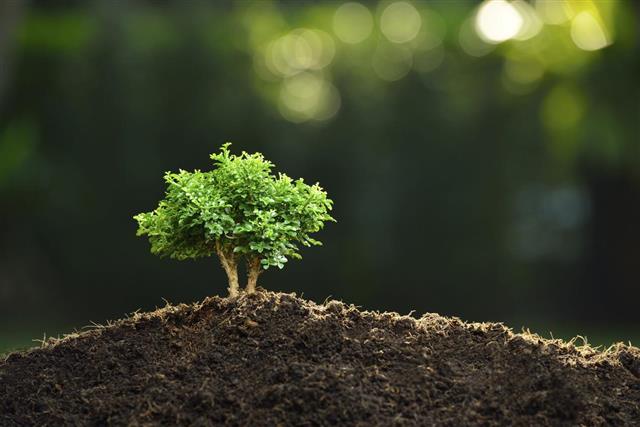
The best bonsai soil meets the prerequisites of supporting a miniature tree, which include good drainage, proper aeration, and retention of water. Preparing bonsai tree soil mix is not so difficult, if you know the components to be added according to the plant type and growing environment.
Training an existing plant into a spectacular bonsai tree is something more than a hobby for gardening enthusiasts. It is all about nurturing the plant and providing its requirements, while maintaining it in a small container. Needless to remind, bonsai is a shrub or a tree, whose growth form is manipulated to resemble a miniature tree. So, its growing prerequisites and care level differ from that of a regular potted plant. Right from selecting the plant species and pot shape to mixing the soil components, everything related to growing a bonsai should be done with utmost care.
Soil for Bonsai Tree: Points to Consider
Frankly speaking, there is nothing like the best soil mix for bonsai. The preferred soil conditions depend on a number of factors. First of all, you should know which type of plant you have. It can be either a deciduous tree (e.g. elm, maple) or an evergreen tree (e.g. juniper, pine). The former requires soil components that have good water absorption capacity, while an evergreen bonsai can tolerate porous, well-drained soil. Accordingly, soil medium for the two bonsai tree types differ from each other. Likewise, take a note of the following aspects while trying bonsai soil recipe at home.
- The soil conditions appropriate for the particular bonsai tree.
- Kind of pot used in planting the bonsai; you can select plastic, wooden, ceramic and clay pots.
- Whether the bonsai is kept indoors or outdoors, in the patio.
- Amount of water provided to the plant in each watering session.
- Size of the bonsai, which usually ranges from 6 inches (miniature) to 3 feet height (large).
- Your geographical location, or precisely, the prevailing climatic conditions.
Preparing Bonsai Soil at Home
Ready-to-use bonsai soil is sold in local garden centers and nurseries. Using the mixture is expensive and many times, it is not suitable for the bonsai tree. So, a cost-effective approach is to prepare bonsai tree soil on your own. With this alternative, you can choose the soil components and decide their quantities, so that the resulting mixture is best suited for your small tree. It should retain adequate moisture without causing water logging problems. Also, the size of the soil particles should be such that the plant roots will get proper aeration.
Usually, garden soil is not used in the bonsai soil recipe. Since it is heavy, the main problem is with water retention or water holding capacity. In short, soil collected from the garden tends to accumulate excess water and reduces aeration. On the contrary, fertile, well-drained, pathogen-free garden soil can be added in a specific concentration. Just remember that the quantity of soil used in planting this miniature plant is less, and you are supposed to provide much-needed plant nutrients and water through it. So, each and every soil component should be selected carefully.
If you are a newbie to the art of growing a bonsai tree, it may sound challenging to prepare the bonsai soil at home. Learning the soil ingredients and their purpose will surely make your task simpler. It is a fact that clayey soil retains water, while volcanic lava allows quick drainage. A simple trick is to understand the basic requirements (water, air, and nutrients) of the bonsai plant, which otherwise is a shrub or tree. The following tips focus on how to make bonsai soil at home.
Gather the Required Supplies
Well, deciding the components for adding in bonsai soil is the trickiest part. Basically, they are of two kinds, viz. organic and inorganic. As the terms indicate, organic soil particles include bark, peat, leaf litter, and plant parts; whereas inorganic oil comprises pumice, volcanic soil (sold as Kanuma), fired-clay soil, and granular clay (sold as Akadama and Turface). In addition, potting soil is used in the bonsai soil mix.
Decide the Ratio of Soil Components
After you have kept the organic, inorganic, and potting soil ready, the next step is finalizing the concentration of each components. Here, the plant type is taken into consideration. For a deciduous bonsai, the soil component that retains water (e.g. granular clay) should be added in higher percentage. In other words, lesser amount of pumice and fast-draining soil is required for a deciduous bonsai.
Prepare the Bonsai Soil Mixture
For a deciduous bonsai tree, keep the ratio of granular clay and pumice to 9:1. Of course, you can lower the amount of clay, provided that peat soil is added for water retention. As for an evergreen bonsai, the quantity of granular clay and pumice is maintained at 7:3 ratio. For adding peat soil, you can reduce the amount of clay and pumice to 5:2. Refer to these examples, and mix the soil components as per the tree requirements.
This way, bonsai tree soil mix can be prepared on your own. Ensuring that the container has bottom holes, line them with mesh screens and introduce coarse soil particles (or pebbles) to ensure proper drainage. After this, you can add a thin soil layer and proceed with the bonsai planting steps. Water the newly planted bonsai and check whether water drains well or not. As the pot is shallow and soil amount is less, water evaporates very quickly, particularly during the hot summer months. In such a case, you can use green moss around the plant stem to conserve moisture.
To maintain a healthy bonsai in perfect shape, stringently follow the watering, trimming, fertilizing, and other care tips for your dwarf tree. Indeed, growing a bonsai tree calls for special attention and lots of patience. But, it is worth spending the effort and time for maintaining this lovely, small version of an ornamental tree.






